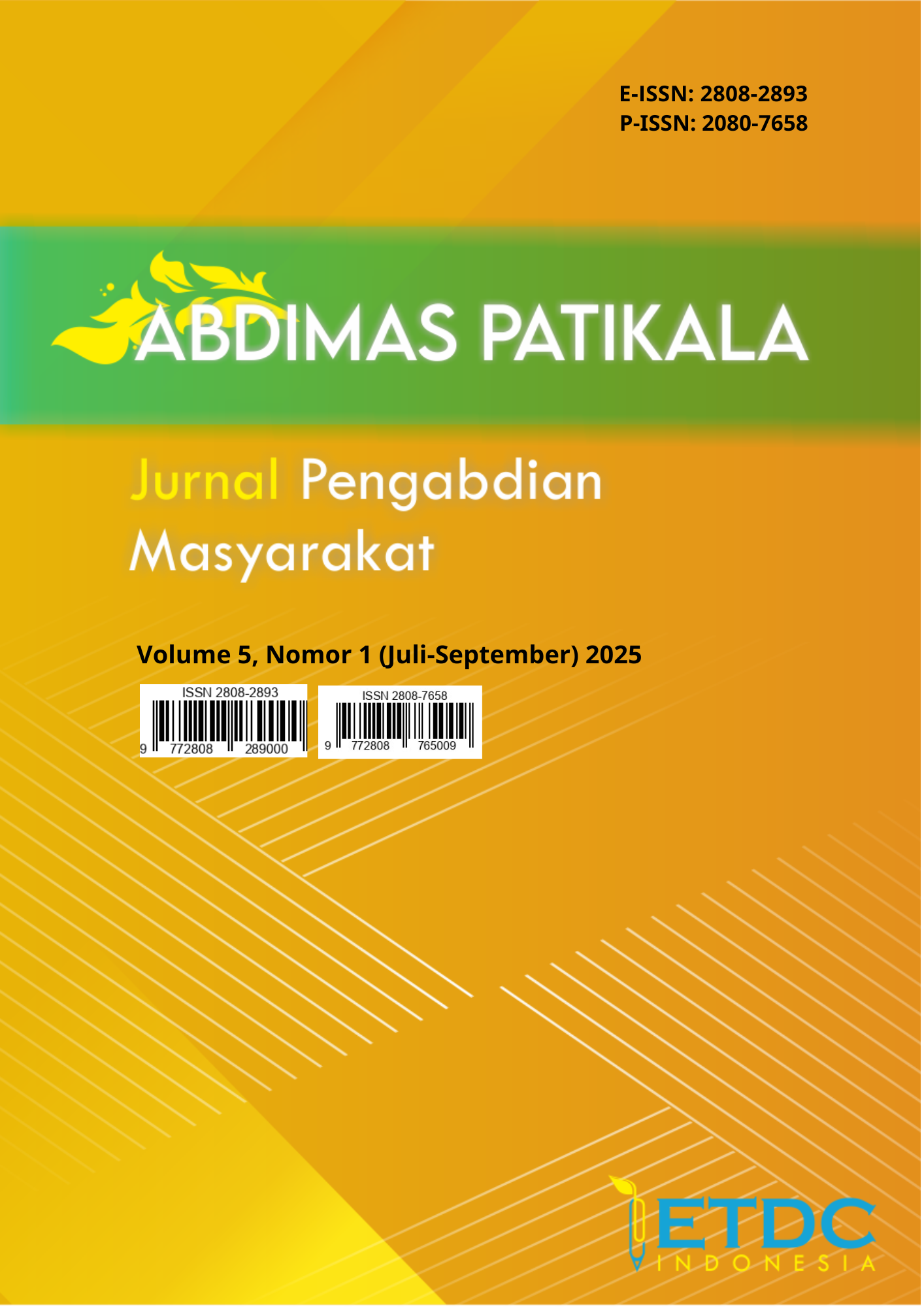Pelatihan Jurnalisme Hijau: Menulis, Menginspirasi dan Menjaga Lingkungan
https://doi.org/10.51574/patikala.v5i1.3711
Keywords:
Ecology, Environmental journalism, Green journalism, Media literacyAbstract
The escalating environmental crisis demands urgent involvement from young generations who will inherit the consequences of climate change. Schools play a strategic role in building ecological awareness, yet environmental education often remains theoretical and detached from students’ daily lives. In response, this community engagement programme was designed to empower high school students with basic skills in environmental journalism, or green journalism, as a medium to communicate ecological issues in an engaging and responsible way. The programme was implemented on 24 February 2025 at SMA Negeri 2 Tangerang Selatan with 80 participants consisting of students and teacher mentors. Using a humanist and participatory approach, the training combined theory and practice: after learning the 5W1H news structure, students directly produced news leads based on environmental photos; small-group mentoring supported confidence building; and social media was utilised to create educational campaigns. Participants were divided into three parallel classes, each with approximately 27 members, guided by lecturers of the Faculty of Communication Sciences, Universitas Mercu Buana. The results indicate significant improvements in students’ journalistic competence and ecological literacy. Post-test results revealed that 85% of participants demonstrated progress in news writing and fact-checking. Beyond technical enhancement, students began to see themselves as ecological storytellers and agents of change. The school also committed to establishing a Green Journalism Club as a sustainable platform for student initiatives. In conclusion, this training underscores that green journalism can serve as both an educational strategy and a participatory avenue for environmental action, enabling students and schools to collectively confront ecological challenges through creative and responsible communication.
Downloads
References
Akbar, W.T. (2024). Penerapan Jurnalisme Lingkungan dalam Pemberitaan Sampah di Media Daring Selama Bulan Ramadhan (Analisis Isi Kuantitatif terhadap Pemberitaan Sampah di Media Daring Detik.com dan Republika Tahun 2021-2023). Jurnal Ilmiah Global Education, 5(1), 220–34. https://doi.org/10.55681/jige.v5i1.1978
Alfath, A. R., Saputra, S., & Hati, P. C. (2025). Jurnalisme lingkungan dalam meningkatkan kesadaran kesehatan masyarakat (studi pada Palembang Ekspres edisi 2024). EduTIK: Jurnal Pendidikan Teknologi Informasi dan Komunikasi, 5(2), 170-184.
Ardoin, N. M., Bowers, A. W., & Gaillard, E. (2020). Environmental education outcomes for conservation: A systematic review. Biological Conservation, 241, 108224. https://doi.org/10.1016/j.biocon.2019.108224
Attwell, C. (2020). Snacking on media literacy: Young children, sustainability, and design in media literacy education. Journal of Sustainability Education.
Batoebara, M. U. (2024). The role of media in increasing go green awareness. Journal of Proceedings: Social Science and Political Science, 4(September), 114–123. Dharmawangsa University. P-ISSN 2798-7280, E-ISSN 2986-6383.
Bernier, A. (2020). Wanting to share: How integration of digital media literacy supports student participatory culture in 21st century sustainability education. Journal of Sustainability Education.
Boykoff, M. T. (2011). Who speaks for the climate? Making sense of media reporting on climate change. Cambridge University Press. https://doi.org/10.1017/CBO9780511978586
Eddyono, A. S. (2012). Media komunitas dan jurnalisme lingkungan berbasis kearifan lokal. Dalam Prosiding Seminar Nasional Menggagas Pencitraan Berbasis Kearifan Lokal (hlm. 89–113). Universitas Jenderal Soedirman.
Grant, L., Vanderkelen, I., Gudmundsson, L., Lange, S., Thonicke, K., Thiery, W., & Seneviratne, S. I. (2025). Global emergence of unprecedented lifetime exposure to climate extremes. Nature, 641(8045), 374–379. https://doi.org/10.1038/s41586-025-08907-1
Iqbal, M., Saefullah, U., & Muchtar, K. (2020). Penerapan jurnalisme lingkungan Detik.com: Studi kasus berita matinya ikan paus di Wakatobi. Warta Ikatan Sarjana Komunikasi Indonesia, 3(1), 34–44.
Jee, S., & Aziz, A. (2021). The application of the process-based writing approach in composing an argumentative essay: A case study of a suburban secondary school of Mukah district in Sarawak. Creative Education, 12(4), 880–896. https://doi.org/10.4236/ce.2021.124064
Jenkins, H., Ito, M., & Boyd, D. (2016). Participatory culture in a networked era. European Journal of Communication, 31(4), 495–499. https://doi.org/10.1177/0267323116659010
McIntyre, K., & Gyldensted, C. (2018). Constructive journalism: An introduction and practical guide for applying positive psychology techniques to news production. Journal of Media Innovations, 4(2), 20–34. https://doi.org/10.5617/jomi.v4i2.2403
Nguyen, J., Abdullah, A., & Park, J.-H. (2024). The Influence of Social Media on Environmental News Reporting and Public Discourse in China. Khulna University Studies, 181–189. https://doi.org/10.53808/KUS.2024.21.02.1212-ss
Ofremu, G. O., Raimi, B. Y., Yusuf, S. O., Dziwornu, B. A., Nnabuife, S. G., Eze, A. M., & Nnajiofor, C. A. (2025). Exploring the relationship between climate change, air pollutants and human health: Impacts, adaptation, and mitigation strategies. Green Energy and Resources, 3(2), 100074. https://doi.org/10.1016/j.gerr.2024.100074
Reynaldi, R. D. Y., & Humeira, B. (2021). Praktik jurnalisme lingkungan di media daring: Analisis isi isu reklamasi Teluk Jakarta di Kompas.com. Jurnal Studi Jurnalistik, 3(2), 21-39.
Rizqiani W, Hidayat N. (2023). Low Public Perspective on The Importance of a Sustainable Environment in The Environmental Journalism Polemic. International Journal of Environmental Communication, 1(1), 1-54.
Sari, M. P., & Okditazeini, V. (2024). Analisis pemberitaan pencemaran limbah PT. Kemilau Permata Sawit di Pesisir Selatan dalam perspektif jurnalisme lingkungan. Kiwari, 3(4), 765–776. https://doi.org/10.24912/ki.v3i4.33143
Sianturi, H. R. P., & Simanungkalit, S. F. (2024). Peningkatan pengetahuan jurnalisme data pada jurnalis lingkungan dalam produksi berita investigasi. JMM: Jurnal Masyarakat Mandiri, 8(6), 6503–6516. https://doi.org/10.31764/jmm.v8i6.27519
Silverman, C. (2014). Verification handbook: An ultimate guideline on digital age sourcing for emergency coverage. European Journalism Centre.
Stevenson, R. B., Brody, M., Dillon, J., & Wals, A. E. J. (Eds.). (2013). International handbook of research on environmental education. Routledge. https://doi.org/10.4324/9780203813331
Ward, S. J. A. (2004). The invention of journalism ethics: The path to objectivity and beyond (Vol. 38). McGill-Queen’s University Press. ISBN 9780773528116
Wardhana AH. (2024). Environmental Journalism on Primate Conservation and Owa Coffee Reporting : An Autoethnography. 2024;16(1):168–85
Downloads
Published
How to Cite
Issue
Section
License
Copyright (c) 2025 Jurnal Pengabdian Kepada Masyarakat Patikala

This work is licensed under a Creative Commons Attribution-ShareAlike 4.0 International License.















